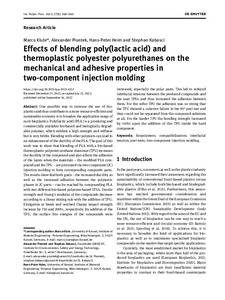| dc.date.accessioned | 2024-01-24T09:23:10Z | |
| dc.date.available | 2024-01-24T09:23:10Z | |
| dc.date.issued | 2022-09-16 | |
| dc.identifier | doi:10.17170/kobra-202401039318 | |
| dc.identifier.uri | http://hdl.handle.net/123456789/15389 | |
| dc.description | Klute, Marco, Piontek, Alexander, Heim, Hans-Peter and Kabasci, Stephan. "Effects of blending poly(lactic acid) and thermoplastic polyester polyurethanes on the mechanical and adhesive properties in two-component injection molding" International Polymer Processing, vol. 37, no. 5, 2022, pp. 568-580. https://doi.org/10.1515/ipp-2021-4212 | eng |
| dc.language.iso | eng | |
| dc.rights | Urheberrechtlich geschützt | |
| dc.rights.uri | https://rightsstatements.org/page/InC/1.0/ | |
| dc.subject | biopolymers | eng |
| dc.subject | compatibilization | eng |
| dc.subject | interfacial tension | eng |
| dc.subject | peel tests | eng |
| dc.subject | two-component injection molding | eng |
| dc.subject.ddc | 600 | |
| dc.subject.ddc | 660 | |
| dc.title | Effects of blending poly(lactic acid) and thermoplastic polyester polyurethanes on the mechanical and adhesive properties in two-component injection molding | eng |
| dc.type | Aufsatz | |
| dcterms.abstract | One possible way to increase the use of bioplastics and thus contribute to a more resource-efficient and sustainable economy is to broaden the application range of such bioplastics. Poly(lactic acid) (PLA) is a promising and commercially available bio-based and biologically degradable polymer, which exhibits a high strength and stiffness but is very brittle. Blending with other polymers can lead to an enhancement of the ductility of the PLA. The goal of this work was to show that blending of PLA with a bio-based thermoplastic polyester-urethane elastomer (TPU) increases the ductility of the compound and also affects the adhesion of the layers when the materials – the modified PLA compound and the TPU – are processed via two-component (2C) injection molding to form corresponding composite parts. The results show that both goals – the increased ductility as well as the increased adhesion between the polymeric phases in 2C parts – can be reached by compounding PLA with two different bio-based polyester-based TPUs. Tensile strength and Young’s modulus of the compounds decrease according to a linear mixing rule with the addition of TPU. Elongation at break and notched Charpy impact strength increase by 750 and 200%, respectively. By addition of the TPU, the surface free energies of the compounds were increased, especially the polar parts. This led to reduced interfacial tensions between the produced compounds and the neat TPUs and thus increased the adhesion between them. For the softer TPU the adhesion was so strong that the TPU showed a cohesive failure in the 90° peel test and thus could not be separated from the compound substrate at all. For the harder TPU the bonding strength increased by 140% upon the addition of this TPU inside the hard component. | eng |
| dcterms.accessRights | open access | |
| dcterms.creator | Klute, Marco | |
| dcterms.creator | Piontek, Alexander | |
| dcterms.creator | Heim, Hans-Peter | |
| dcterms.creator | Kabasci, Stephan | |
| dc.relation.doi | doi:10.1515/ipp-2021-4212 | |
| dc.subject.swd | Biopolymere | ger |
| dc.subject.swd | Kompatibilität | ger |
| dc.subject.swd | Grenzflächenspannung | ger |
| dc.subject.swd | Spritzgießen | ger |
| dc.subject.swd | Mehrstoffsystem | ger |
| dc.subject.swd | Adhäsion | ger |
| dc.subject.swd | Mechanische Eigenschaft | ger |
| dc.subject.swd | Polyesterpolyurethane | ger |
| dc.type.version | publishedVersion | |
| dcterms.source.identifier | eissn:2195-8602 | |
| dcterms.source.issue | Heft 5 | |
| dcterms.source.journal | International Polymer Processing | eng |
| dcterms.source.pageinfo | 568-580 | |
| dcterms.source.volume | Band 37 | |
| kup.iskup | false | |

